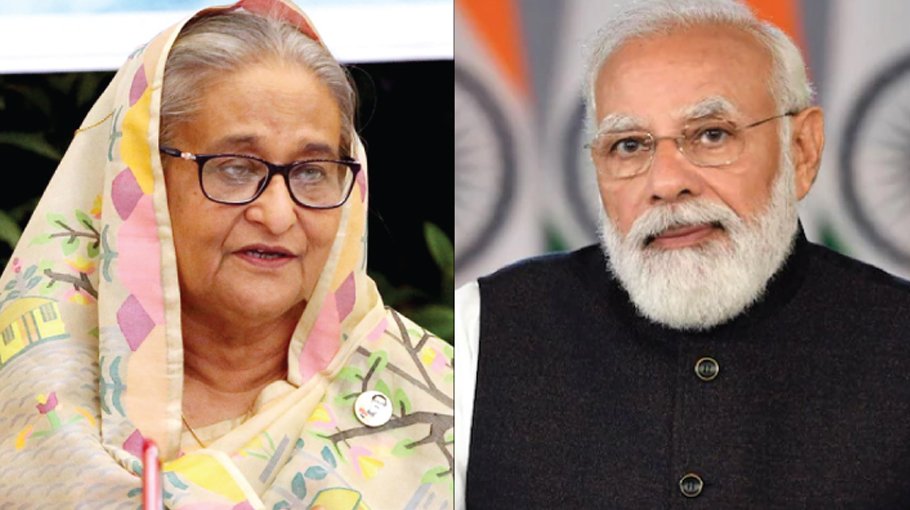Eco safety measures in Rampal power plant unique
Hasina, Modi to jointly announce the completion of unit-1

The Maitree Super Thermal Power Project (2x660MW) of Bangladesh and India at Rampal, popularly known as Rampal power plant in Bagerhat of Khulna division, has been incorporating environmental friendly measures right from the design stage.
At the end of the unit-1, project director Subhash Chandra Pandey said the technologies they had used in the entire project were “unique” when it comes to mitigating the environmental concerns.
“From the environmental perspective, two things we need to deal with for a coal-fired power plant - one is greenhouse gases and the other is sulphur dioxide, a gas pollutant. Our project is critically committed for the pollutant free generation,” he said, during a visit to the plant on Monday, as Unit-1 was successfully synchronized with the national grid on August 15.
Prime Ministers of Bangladesh and India will jointly announce the completion of the plant during the visit of Prime Minister Sheikh Hasina to New Delhi in the first week of September.
The relevance of coal-fired power plants is felt again in the advanced world in the wake of the Ukraine-Russia war. Germany has put back an old coal-fired power plant on to the network following the debate of how Europe’s largest economy will cope without Russian gas. Countries like India and China are dependent on coal for power generation.
The Rampal power plant, which is being seen as a major step in further strengthening India–Bangladesh Power Sector Cooperation, will go into commercial operation in October, raising the country's electricity generation capacity further.
It is being constructed under the government of India’s Concessional Financing Scheme by Bharat Heavy Electricals Limited (BHEL) for the Bangladesh-India Friendship Power Company Private Ltd (BIFPCL), a 50:50 Joint Venture Company between India's NTPC and Ltd and Bangladesh Power Development Board (BPDB).
The 1320 (2x660) MW coal-fired thermal power plant is being set up at a cost of approximately $ 2 billion and is located in Rampal, in the Bagerhat district of Khulna Division of Bangladesh.
Some of the in-built measures to minimise air and water pollution, inter-alia, include a Flue Gas Desulphurization System (FGD) with no bypass to control the emission of SOx,
Integrated Effluent and Waste Management System to avoid contamination of Pasur River, construction of the tallest Chimney in Bangladesh (at 275 m) for wider dispersion of flue gas emissions, construction of an advance Ship Unloader for coal as well as a fully covered Coal Stock Yard, along with use of High Grade imported coal with low Ash and Sulphur content, among other measures.
The project Director, Pandey, explained that for greenhouse gases they have used the “highest efficient technology in the machine itself”.
“Our project is ultra super critical. So we are using machines which consume less coal per unit of energy production. We try to minimize the greenhouse gas which was the first consideration in the design”.
“Second is environmental pollutants that we should handle better. So the oxides of sulphur are removed by incorporating the Flue-gas desulfurization (FGD) method which is a set of technologies used to remove sulfur dioxide (SO2) from flue gases,” he said.
“In case of Rampal, I would say it’s a unique feature. We don’t have bypass facilities. If the FGD system is not commissioned, if the FGD system is not functioning, then the unit will be shut down,” he said.
They use high-grade coal with low ash and low sulphur content, and also use high efficiency electrostatic precipitators (ESPS) that removes fine particles like dust, low Nox emission technology to remove nitrogen oxide (Nox) gases.
The height of the chimney is 275 metre which is taller than other plants to minimize environmental impacts of flue gases.
“We are using covered barges for the transportation of coal. Covered coal sheds are being used in the plant to control fugitive emission,” he said, adding that they have dedicated effluent water treatment plants – effluent treatment, sewage treatment and solid waste treatment.
“How we handle the ash is also unique. We’ll not dispose of ashes to water. We have an ash collection system and entire ashes will be utilized in cement factories or for landfill. That will also prevent pollution”.
“It’s a new plant. The project designers are looking for 30 years or 35 years of its operation from today when the environmental norms and parameters will be much stiffer,” he said.
Once a marshy area, the 915.5 acres area of the Rampal power plant now has a modern look. The company under the project is also helping the local poor people with medical camps, water filter distribution and wheelchairs. Over 100,000 trees have been planted around the area.
Earlier, on 6 April, the 400 kV GIS Switchyard and Interconnecting Transformer of the Power Plant was energized.
Since then, it has been providing a wheeling facility of the 400 kV power from the Payra Power Project to the 230 kV grid system of Bangladesh to enable the Power Grid Corporation of Bangladesh to transmit additional power towards Khulna region to address peak demand.
After completion and successful synchronization of Unit-I of the Power Plant, further synchronization related activities are currently being undertaken following which Unit-I will be handed over to the government of Bangladesh.
Unit-II of the Power Plant is expected to be commissioned early next year. Once both Units are commissioned, the Maitree Super Thermal Power Project is expected to be one of the largest power plants in Bangladesh.



